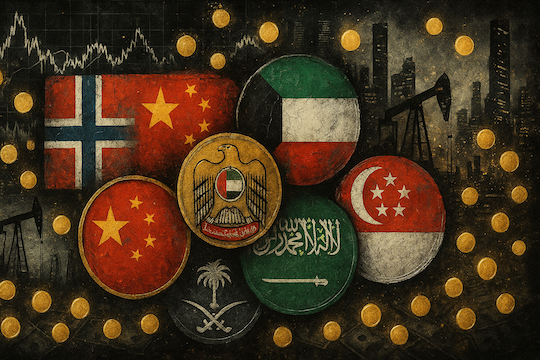
Posted August 25, 2025
By Matt Insley
99 Sovereign Wealth Funds and Counting
A sovereign wealth fund (SWF) is a state-owned investment entity, financed primarily through trade surpluses or other revenue streams such as investment income and royalties, that nations use to manage and invest excess reserves.
As Paradigm’s macro expert Jim Rickards explains: “A country works just like an individual — if you make more than you spend, you accumulate the excess as a reserve.
“Before World War I, countries almost always held their reserves in gold and silver. This was called the mercantilist system. The more gold and silver you had, the more powerful you were.
“Countries (or empires) that saw their gold and silver slipping away would take extreme measures to stop the outflow.”
During the Bretton Woods era, the U.S. dollar became the anchor, linked to gold, prompting surplus nations to purchase U.S. Treasury securities instead of gold — a status cemented even when President Nixon closed the gold window in 1971.
In the modern age, “about 60% of all global reserves [are] held in U.S. Treasury securities,” says Jim, with the rest distributed among other major currencies and gold.
Central banks have traditionally prioritized safety and liquidity, evidenced by the preference for short-term Treasury bills, a practice intensified after the Asian/LTCM financial crisis of 1998 when “central banks increased their reserve positions enormously on a 'precautionary' basis as protection against a new financial crisis.”
As these reserves grew, nations recognized that keeping large portions in low-yield assets like cash was inefficient. This realization led to the creation of SWFs: separate entities tasked to invest in riskier but potentially higher-return assets, including equities, real estate and corporate debt.
The number of SWFs exploded in the early 21st century; from only 20 in 1999, the number skyrocketed to 99 globally by today.
Send your opinions to, feedback@newsyoucanacton.com
Your Rundown for Monday, August 25, 2025...
The U.S. Question: Funding and Control
These SWFs manage over $9.1 trillion in combined assets, with a mere ten funds controlling more than 78% of that wealth — Norway, China, UAE, Kuwait, Saudi Arabia and Singapore sit atop this list. .
The aggregate asset allocation of SWFs is diversified: 30% in equities, 28% in bonds, 23% in illiquid alternatives like private equity and hedge funds, 4% in liquid alternatives, 10% in strategic investments and 5% in cash.
“SWFs hold relatively little gold, which is more typically held by central banks and finance ministries,” notes Jim. Over 57% of SWF assets are funded by natural resources such as oil, gas and metals, further underscoring their strategic economic position.
SWFs wield immense influence in global financial markets not just due to their sheer size, but also because their investment behaviors tend to align, magnifying market shifts. As Jim observes: “Managers tend to act in similar ways based on uniform risk models, even if there is no outright coordination.”
This synchronicity means that even a gradual withdrawal from a sector — such as technology or AI — could trigger significant market reversals or even crashes.
However, the power of SWFs is not purely economic. They can also be used as instruments of geopolitical influence or as potential financial weapons.
Jim recounts meeting with officials from the China Investment Corporation (CIC) and notes how SWFs have raised concerns within intelligence communities about “financial warfare, market manipulation, or acquisitions of U.S. target companies for the purpose of extracting valuable intellectual property or classified information.”
Determining the line between legitimate capital deployment and strategic manipulation is not always straightforward, adding a layer of complexity to their role.
The prospect of establishing a U.S. SWF brings fresh challenges. Unlike the typical surplus-funded structure of most existing SWFs, the U.S. runs a persistent trade deficit. Jim points out that financing a U.S. SWF would require innovative approaches — perhaps via Treasury borrowing (thus resembling a leveraged hedge fund), revenues from tariffs or monetizing existing federal assets such as gold reserves, public lands or even seized cryptocurrencies.
Yet, such mechanisms are fraught with complications: “The debt aspect makes the SWF look more like a hedge fund using leverage,” and political hurdles could arise, especially around issues like the national debt ceiling or asset monetization.
Governance presents another critical question. Should management be entrusted to large asset managers like BlackRock or to government appointees? Jim stresses: “The most important issue is whether the U.S. SWF will be managed strictly for high risk-adjusted returns or whether it will be weaponized to pursue geopolitical goals through financial manipulation.” The direction chosen will profoundly influence not only the fund’s investments but also broader market outcomes.
With more questions than answers at this stage, Jim concludes: “Knowing the right questions leaves us in a good position to interpret announcements and stay ahead of the curve when it comes to the impact on markets that a U.S. SWF will have.”
“That impact will affect your personal investment portfolio,” he adds. “We’ll be following developments and keeping you informed every step of the way.”
Market Rundown for Monday, August 25, 2025
S&P 500 futures are down 0.30% to 6,430.
Oil is up 0.60% to $64 for a barrel of WTI.
Gold is down 0.15% to $3,413.70 per ounce.
And Bitcoin is down 1.50% to $111,455.

Pritzker vs. Noem: The Battle Over Halloween
Posted November 03, 2025
By Matt Insley

Starving the System… and the People
Posted October 31, 2025
By Matt Insley

Elon Just Killed Wikipedia
Posted October 28, 2025
By Matt Insley

The Most Underowned Bull Market in the World
Posted October 27, 2025
By Matt Insley

We’re Crash Test Dummies Now
Posted October 24, 2025
By Matt Insley
